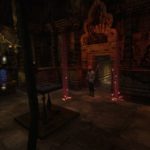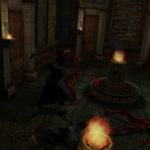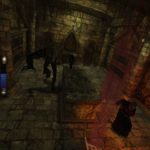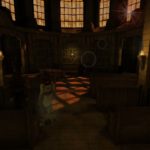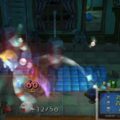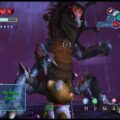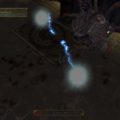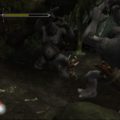Developer: Silicon Knights Publisher: Nintendo Released: 06/24/02 Genre: Action
As a Nintendo 64 owner until the very end I looked forward to Eternal Darkness almost as much as Zelda. As one of the proposed last N64 games it was ambitious as hell and the glowing previews indicated it was special. But my years of anticipation would grow even longer as it was moved to the GameCube. I will admit I was disappointed; I knew it would turn out better but still wanted to see it on its original platform. The numerous upgrades it received proved worth it and while it didn’t have the impact that many expected it still remains a unique experience even to this day.
Story plays heavily into Eternal Darkness and it encompasses a wide swathe of characters. The basic plot is that there are three Elder Gods battling for supremacy with mankind caught in the middle. The central figure is Alexandra Roivas, a young woman who has inherited her grandfather’s mansion after his gruesome death. The police are of little help in the investigation and so she searches the mansion for clues. These clues lead her to his research into the Tome of Eternal Darkness as she fights in his stead.
The story is incredibly ambitious as it covers the largest span of time outside of Civilization series. From 26 BC to the modern day the war against the Elder Gods has touched many lives and you get to experience each one. It is an incredibly diverse cast too; you play as a Roman Centurion, an architect, a Franciscan Monk, and even a firefighter in the present. While Alexandra is the main character her role is as a bridge to these separate stories until the end. How these disparate stories connect is one of the game’s best aspects. You revisit many of the same locations with different characters but with new areas or a different context. The actions of each character have many lasting repercussions that only become apparent later. Silicon Knights do an excellent job in this regard and while some don’t have happy endings you’ll become invested nonetheless.
What makes Eternal Darkness unique is its solid set of mechanics. Despite thirteen separate playable characters the base mechanics never change. You can target individual body parts regardless of weapon. This is one of the most crucial skills in the game to master. Removing an enemy’s head will cause them to flail about, avoiding you and possibly killing their allies. Cutting off arms means they cannot attack. For a larger enemy like a Horror disarming them is paramount as they have a long reach. Later creatures have specific weak points to target. There is a specific character that can perform autopsies that everyone later has access to and can study. It is not perfect; because of the camera the cursor jumps around or sometimes won’t move. It is frustrating but easy to deal with.
Because the story jumps around you get to play with era specific weaponry for each character. It is a pretty massive armory with more swords, guns, and other blades than you can imagine. Adapting to specific quirks is surprisingly fun too. Ella’s blowgun fires poison dart that are slow acting. You need to avoid getting hit while it takes effect. Maximillian’s flint lock pistol can fire a single shot before it needs reloading. Search and you can find a second pistol and dual wield, becoming a middle century bad ass with….two bullets. The environment also plays a factor as well. Karim gains a large two hand sword later in his chapter but cannot fully swing it in a narrow corridor. Someone like Anthony struggles with a two hander as well. Some chapters feature more combat than others and take these limitations into account or have another focus.
There are many puzzles in the game that are easier to manage than in similar titles. The game provides enough clues that even a dullard will figure them out. They do become more complex late in the game and begin relying on magic to solve. The magic system looks complex but is simple in practice. Spells are learned from scrolls and cast with a 3, 5, or 7 point array to increase their power. In addition each spell can use one of three alignments, Red (Chatturga), Blue (Mantorok), or Green (Xel’lotath). There is a rock, paper, scissors element when it comes to alignment which you need to learn as well. Spells run the gamut from healing, self-defense, enchantment, and summoning. It is actually game breaking; magic recovers quickly over time and there is no penalty in waiting. It also trivializes the game’s signature element, the sanity system.
Possibly its most famous element, the sanity system is both subtle and disturbing. As you encounter the various monsters in each chapter your sanity will drop. Each character has a different amount of sanity and loses it differently. Someone like Ella and Anthony, who probably rarely see combat, have little sanity and it depletes quickly. Battle hardened veterans like Pious Augustus either do not have sanity bars or are hardly affected. Performing a finishing attack on weak enemies will restore it. You can also lop off a monster’s head to avoid the loss; clever isn’t it?
The reason sanity is so important are the effects it causes. At a basic level letting it drop too low will cause you to take extra damage or lose health. There are around fifty sanity effects and they vary heavily. Some are incredibly subtle. You might hear chanting in the background or your characters mumbling to themselves. Then there is the unnerving like hearing doors banging or blood dripping from the walls. Let it dip too low and it gets extreme. Your character might randomly explode when casting magic, or lose body parts one by one. The game might inform you the controller is unplugged as you lose control and are torn to shreds. It is all just to mess with you as the current room resets with no consequences. I purposely left out some of the more extreme effects as it is best to experience them personally.
The move to the GameCube saw a significant upgrade to the presentation. The level of detail in the environments approaches pre-rendering at times. Indoor areas offer show off beautiful lighting and shadow effects amongst the intricate architecture. There is even some light bump mapping that makes certain details pop. Character animation is smooth and changes depending on your equipment. And the framerate never drops no matter how many enemies appear. Eternal Darkness shows some aspects of its N64 roots though. Certain character models are still very blocky with subpar textures. It is apparent some areas saw more work than others. It only stands out due to the rest of the package.
The sound design is all around excellent with a sweeping score that is both haunting and melodic. The sound effects such as banging doors, footsteps, and demons wailing will have you on edge at all times, especially once your sanity dips below the halfway mark. The voice acting is especially strong overall with no weak performances to speak of. There is some repetitive dialogue between protagonists; most notably the nervous chatter of insanity but it does not mar the strong sound design at all.
In Closing
Eternal Darkness is one of the best GameCube exclusives and still pretty unique today. Eternal Darkness delivers with a great story, top notch voice acting and solid mechanics to create one of the better adventure games from that period.

